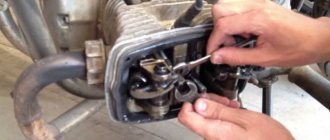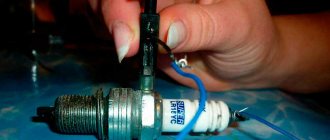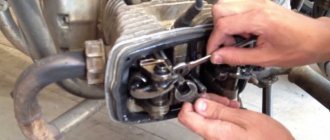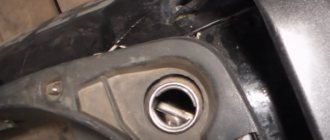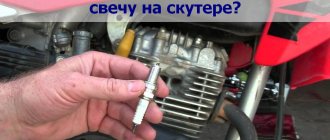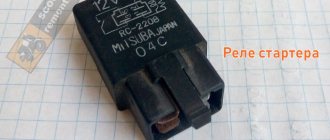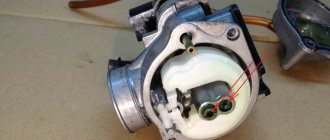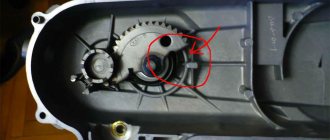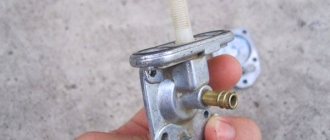The scooter does not start, there is a spark, but gasoline is flowing - what to do to fix it. We diagnose faults in the field with our own hands and mind.
So, no matter what kind of scooter you have, 2T (two-stroke) or 4T, you need to first remove the spark plug. However, you have already done this, since you checked that there is a spark. If the spark plug is wet, let it dry; if it is dry, then gasoline still does not flow into the chamber. This could be due to the carburetor, or due to problems with the timing belt and valves (if you have a 4T). It happens that the sprocket on Chinese scooters jumps by 1 tooth. But, before looking at the marks and getting into the timing belt, check the reed valve.
Petal - also vacuum, usually located under the gas tank. Create a vacuum through the tube from the carburetor - gasoline should flow. If it does not flow, then change the valve, or simply pierce the membrane with a wire and plug the vacuum hose with a stick.
If there is compression, then you need to look at the carburetor and valve mechanism. Naturally, the carburetor breaks down more often. You can again look at the symptoms by looking at the candle - if it’s white, then there was a deficiency of the mixture, if it’s black, it’s over-enriched. Check the air filter or temporarily remove the pipe. Try spraying carburetor cleaner. It is not recommended to disassemble it without experience.
Again, it can clarify a lot whether the motor seizes or not. If there are no flashes at all, then most likely it is the timing belt or a burnt-out piston. If there are flashes, then the carburetor.
One thing is good, if the scooter does not start there is a spark, then your generator is fine. By the way, the spark may be weak, it is also better to change the spark plug and check the switch, but usually there are at least flashes in the cylinders.
Why won't my scooter start?
I think everyone has encountered a situation when, after a winter period of inactivity, the scooter does not want to start. But there are a lot of other situations in which the scooter does not start. In this article we will try to find out all the possible reasons why the scooter does not start and we will try to eliminate them. There are several main reasons that can make it difficult to start an engine.
Let's get started. The first reason is the most basic - check whether fuel is entering the carburetor. This can be done by unscrewing the fuel drain screw from the carburetor. If there is no fuel in the carburetor, then check its presence in the gas tank, see if the air access tube into the gas tank is clogged. The fuel filter could become clogged or the vacuum pump could fail. It would also be a good idea to check if the needle in the float chamber is sticking.
If everything is in order with gasoline, then we move on to the second stage - checking the presence and quality of the spark on the spark plug. We unscrew the spark plug, connect the armor wire to it, turn on the ignition, lean its metal part against the engine and, turning the crankshaft, see if there is a spark. If there is no spark or it is very weak, then the problem may be in the spark plug itself - try cleaning or replacing it. Perhaps the ignition switch, generator have failed, or the ignition coil has broken. As a last resort, check the functionality of the ignition switch.
If there is a spark, then you need to check the compression in the cylinder. This can be done using a special pressure gauge or simply by plugging the spark plug hole with your finger and turning the crankshaft. With normal compression, the finger should be moved away by the air flow. Otherwise you have problems with the piston. You will have to disassemble the engine and check the condition of the rings, piston, valves, condition of gaskets and seals (crankshaft) (they should not suck in air).
Often, the engine does not start due to problems with the carburetor. In this situation, remove the carburetor and clean it completely. You need to wash the carburetor in clean gasoline, after which you need to blow out all the channels with compressed air. Also, one of the reasons why the scooter does not start may be that the air-fuel mixture is incorrectly adjusted. Perhaps the mixture is too rich or too lean.
Do not forget to also check the serviceability of the starting enrichment. Remove it and connect it to the battery. after 5-10 minutes its rod should move forward a few millimeters. Carry out the work 30 minutes after removing the enrichment agent.
After checking all the reasons stated above, you must find exactly the reason why the scooter won’t start. Having eliminated it, you can easily start the engine.
Sequence of repair actions
The main rule for detecting malfunctions and repairing a scooter is to step-by-step eliminate the elements of the system when identifying the causes of a breakdown in any of them. Search and repair, especially when starting from the starter, must be done in accordance with a strict sequence, where the chain may act as the beginning, and the end, for example, if there is or is no spark. It is worth noting that you do not need to immediately run for a new switch for the scooter, first make sure that the generator is functioning perfectly, only after that test the wiring if there is no spark, etc.
Checking Basic Systems
It is important to remember that gasoline has the ability to lose its properties if it sits in cold weather and may not even ignite. Also, before making a final diagnosis and starting to repair the moped, if it does not start from the starter, you need to make sure that the spark plug can do its job and the carburetor is functioning normally
Remember that the scooter starts from the starter when it has an integral part with proper operation of the variator, clutch, camshaft group and valve. To put it simply, if all power systems are in normal condition, then there is a problem in the transmission, thanks to the crankshaft torque, which works closely with the variator.
In the process of diagnosing and repairing a scooter, in some cases it is necessary to do a thorough check of not only individual elements, but also the entire system. For example, if there is debris in the carburetor, provided that it is intact and the air filter is saturated, the presence of dirt in the cavity of the gas tank and the fuel filter is also carefully examined.
Chinese scooter lovers club
Chinese scooter lovers club forum
Time zone: UTC + 3 hours [Summer Time]
Forum Rules
If your question concerns a malfunction of your scooter, or you have any difficulties with operation or tuning, first indicate: Model and manufacturer of the scooter: Engine model: Engine stroke and estimated volume: After that, explain the essence of the problem. Don’t forget, the title of the post should reflect the essence of the problem as closely as possible.
Checking the engine power system
First of all, you need to make sure that there is enough gasoline in the gas tank. There is a small tube inside the gas tank that takes gasoline not from the bottom of the gas tank, but a little higher. Therefore, it may turn out that there is still gasoline in the tank, but it does not flow into the carburetor. Therefore, if possible, add gasoline to at least half the tank and try to start the moped again. Perhaps this is the reason.
You also need to know that the gas tap of the Alpha moped has two positions: in one, it takes gasoline closer to the bottom of the gas tank, and in the other, a little higher. If you don’t know in which position the gas tap is open, try installing it in a different position, maybe this will help.
It is very convenient to check the gasoline supply if you have a transparent tube from the gas tank to the carburetor, or have a replaceable gas filter installed. In this case, you can immediately see whether there is gasoline or not.
There is also another simple check of the power system: take a small amount (5-10 ml) of gasoline into a syringe, remove the air intake tube from the carburetor and pour gasoline directly into the carburetor. If after this the moped starts up, or as they say “catch,” then the reason is definitely in the gasoline supply and you need to check the fuel supply and carburetor.
If after all the described checks the problem is not found, there is one more check left - checking the engine compression.
Article “scooter won’t start”
It may not start 1 - if the spark plug is broken (damp, sooted, faulty), the spark is not in time (the wires from the sensor are turned over on 2t it can start in the other direction, on 4t 1 wire cannot be turned over), the rotor is not tightened or the rotor key is turned , the stator is unscrewed, the commutator is faulty, but there is a spark, a weak spark is due to a breakdown or interturn short circuit in the ignition coil, in the ignition windings, the battery is discharged (DC SDI), the resistance in the cap has burned out, breakdown of the cap, coil and explosive wires to the housing , the alarm system is faulty (it is better to turn it off during the test), the brake was not pressed, and the side stand was not removed. 2t in such cases it is better to start the revs higher with kick, for 4t XZ, combine battery. 2- poor compression: wear of the rings or cylinder (large gap in the ring locks for 50cc 0.15-0.25, for cubic capacity 0.2-0.35), burnt rings (no longer springy), rotated rings (4t, locks come together) , spread at an angle of 120 degrees, all rings), stuck rings (they don’t come out of the grooves well, coke, remove and clean the grooves), large scratches and grooves on the piston and cylinder (replace the cylinder head), leaking valves, stuck valves due to a bent valve stem and breakdown of the gasket under the head (such as a slapping knock). Checking the compression. 3 - low-quality fuel, change it, drain the old one from the carburetor, fill the float chamber with new one, restart the engine, start it. 4 - lean starting mixture (the spark plug is dry, it may seize, but will not start), fuel does not flow well into the carburetor, the starting enrichment is stuck closed (very rare), the jets are clogged, including the enrichment, air is leaking through a leaky pipe (manifold), crankshaft oil seals for 2t are torn or do not hold well, fuel does not flow well from the tank to the carburetor (the filter is clogged, the vacuum valve is faulty, the hoses are looped upward), the filter element is installed crookedly in the air filter, air passes in addition to the filter element, the filter is dry (rinse and soak ) 5 - rich mixture, the spark plug is immediately filled in after 3-5 kicks, the float shut-off needle is clogged, the vacuum valve is faulty, fuel is sucked into the engine through the vacuum hose, the jet has been unscrewed, the air filter pipe has closed the air channels of the main system (at 2t). 6-4t the timing chain has jumped, the valve timing is incorrect. We check the correct installation by the mark on the rotor, TDC and camshaft position. 7- There are also cases when the weights get lost in the varicose, the engine is immediately loaded with a wheel and it is difficult to bring it in.
This is interesting: Experts have named the speed that is fatal for drivers during an accident
And crazy malfunctions like: I didn’t pump gasoline into the float chamber and start it, didn’t connect the air vent, forgot to put on the cap, connect the wires, turn on the ignition. Disarm alarm, etc. It's up to you.
First, you need to create easy starting conditions: put it on the center stand, turn on the headlights (when it’s off, the resistor works, when the headlights are on, they can take a lot on themselves), the lightest dimensions on the engine.
Ways to start the engine It won’t start, we quickly figure out why, if it’s cold, we plug the air filter and start it, we don’t turn up the gas to 2t, since the XX + enricher setting should ensure a normal starting mixture at XX (at XX the starting mixture is normal, with gas already lean 2t or rich 4t, so a cold engine starts better without gas, and a hot one with gas booster for 2t, 4t vice versa), it doesn’t help, unscrew the spark plug, check the spark, if the spark plug is dry, check the flow of fuel into the float chamber, if necessary, remove the vacuum hose, suck in and look on a car filter or a transparent hose, gasoline began to flow into the carburetor; for better filling, repeat the operation 3-4 times (it helped to fill more, starting a cold engine more confidently). If the spark plug is damp, check the spark, there is a spark, install a new working spark plug with a smaller gap, start it, it won’t start, turn the gas all the way to 2 tons and try to start it and do the rest of the G, after pumping 5-10 kicks (maybe it starts to seize), let off the gas, start it. If everything starts fine. It won’t start, change the fuel, drain the sediment from the float, do the rest, change the spark plug, start it. It won’t start, at 2t we check the crankshaft seals, suction through the intake manifold (pipe). For 4t pipe, timing, valve adjustment, compression. It won't start when it's hot, full throttle and start 2t. 4t just remove the air filter or remove the vacuum hose, drain the sediment, do the rest, replace the hose and start it. It works unsteadily, we try to de-gas it, then we determine if it stalls at idle or the speed fluctuates, we look for air leaks, it works hard and there are interruptions in the operation of the engine, we look for the cause of the overflow. We check for misfires and change the spark plug. And once again, 2t starts better with a kick, 4t, as suggested below, with a well-charged battery, better with a car battery. Good luck to all!
Last edited by funix on Dec 08, 2010 11:16 pm, edited 2 times in total.
A helmet for cycling is not required, but is advisable.
According to the traffic rules of the Russian Federation, a helmet is required only for moped drivers. But traffic police inspectors, when issuing licenses to schoolchildren, check for the presence of a helmet. The exam is accepted only if it is available.
They also warn parents about the responsibility of children riding without helmets and the risk of serious injury. A helmet protects the bicycle driver during impacts and falls. It reduces the likelihood of traumatic brain injury by 63-88%.
A child can ride a bicycle on the roads from the age of 14, but a license is required and protective equipment is desirable: a helmet and special glasses. If you explain all the dangers of Russian roads, you can easily convince your child to use what is necessary.
Principle of operation
Why won't my scooter start? There can be many reasons for this - from a small malfunction of the engine to a serious breakdown.
A moped differs from other types of vehicles in that it is an economical mode of transport. A typical average scooter has a 50cc engine, which is unable to burn too much fuel while driving. This explains the fact why it cannot reach very high speeds. The maximum he can do is move at a speed of no more than 60 kilometers per hour. At the same time, the safety of the moped driver is at risk, since no side safety bars are provided here, as on full-fledged motorcycles. But the reliability and simplicity of the design of this relatively cheap vehicle are so convenient for everyday use that the scooter has always been, is and will be popular among the people.
But even the most unpretentious equipment sooner or later begins to act up and let down its owners. And then one fine day you are faced with the fact that the scooter will not start. This may be due to careless handling, lack of timely technical inspection, as well as objective extraneous causes, consequences of an accident, and the like.
Alfa moped no spark
Tamanho do video:
Mostrar controles do player
- Publicado em 14 Out 2014
- After work we were going to go home, but my friend’s moped didn’t start. He unscrewed the spark plug, there was no spark, replaced it with another one, the same result. Since it was one o’clock in the morning, he pushed his moped to my garage, and I drove him home ( he lives in a neighboring village). In the morning I decided to see what the reason was. First, I checked all the contacts, then I rang the armor wire with a multimeter, then I changed the coil (I have it in stock). There was still no spark, then I changed the switch (I removed it from my moped) , but the spark never appeared. But when I checked, the current from the armored wire began to flow and I decided to try to install my own spark plug, as it turned out the whole problem was in the chip from the switch, the contacts went loose there, but when the spark disappeared, the owner changed the spark plug to a non-sparking one working. His second spare one was also not working. In the end, of course, I found a malfunction, but it could have been found faster. I concluded for myself that in any case it is necessary to check the functionality of the spark plug (even if they only installed another one before your eyes)) ), well, the owner didn’t draw any conclusions and I’m waiting for him again in my garage soon))). Naturally, not everything was included in the video, since it would have turned out to be a very long video, so I had to cut something out.
- Automoveis
- Moped (Product Category)Auto Show (Event)moped alphamoped deltaalpha rulitchina rulitalfa 120km/hrotates for alfemoped alpha tuningmoped alpha repairchinese moped alfairbis viragoalpha phantomirbis virago
Probable causes of breakdowns
Why won't my scooter start? There may be a variety of reasons for this. You take it to the track to start and go to work or for a walk, but the starter does not respond. The scooter often has trouble starting after an accident or a long period of inactivity.
Possible reasons for engine silence may be the following:
— battery discharge; — breakdown of the fuel distribution mechanism; — soot getting on the spark plug; — curvature and deformation of the belt in the motor design; — wear of the piston in the engine, wear of its components.
Each of these reasons requires careful consideration in order to solve the problem. The scooter sometimes does not start due to a manufacturing defect. In this case, repairs will be pointless, because they will take a lot of time and require money.
The moped has lost spark, what should I do?
Very often the reason that the engine does not start is the lack of a spark at the spark plug. This is diagnosed very simply:
- you need to unscrew the spark plug from the engine (or take a spare one),
- put a candle cap on it,
- turn on the ignition,
- press the spark plug to ground
- crank the engine with the starter, or better yet, with the kickstarter.
If a spark does not jump between the electrodes of the spark plug, the engine will not start.
But fortunately, the ignition system on Alpha mopeds is quite simple and you can find the fault on your own.
I always try to follow the principle “from simple to complex” when troubleshooting. That is, before disassembling half of the moped, you need to try to check everything that is easy and cheap to check.
First, remember what preceded the malfunction: some work may have been carried out or there may have been mechanical damage (for example, the moped fell). If something like this happened, start troubleshooting from there. There is a high probability that upon inspection you will find a broken wire, damaged insulation, a damaged connector, or something else.
Be sure to try cranking the engine with a kickstarter; it happens that the starter turns too slowly and there is no spark.
Solutions
This problem can be resolved in two ways. For example, use the kick starter located on the left side near the engine. Pressing it will activate the remaining energy in the generator, and this small dose of energy will start the battery. This charge will not last long, but will allow you to get to the nearest place to charge. The generator's armature and brushes store enough energy to revive the battery. But this is not the only way to “save” the battery:
- if the scooter does not start (there is a spark, there is gasoline), just charge the battery for several hours. The current level should be similar to that in the battery. Otherwise there is a risk of the battery burning out.
Exhaust pipe clogged with carbon deposits
In this situation, the scooter does not pull at all and stalls.
You need to remove the pipe and check it for ventilation. There may be carbon deposits inside the pipe or some partition has broken off, blocking the exhaust.
You can also check the pipe without removing it from the scooter: at idle, if the pipe is not clogged, the smoke comes out in a pulsation, approximately at the beat of the engine.
And if the pipe is clogged, then the smoke comes out at high speed in a continuous stream. This indicates a reduction in the throughput hole in the exhaust pipe.
Problem with flammable composition
If the scooter does not start, there is a spark, there is gas, but there is no movement, this is a very serious breakdown. It has a working starter, but nothing helps? Perhaps the problem lies in the fuel distribution mechanism. It is better not to repair such breakdowns with your own hands - the hands and eyes of specialists are needed here.
If you have money, it is better to send the scooter to a service station. There is special equipment that can be used to re-flash the built-in injector chip (if it is not a carburetor engine).
Second phase
Knowledge about braking will help preserve your health while moving. How to drive a moped? Learn thoughtfully and at the moment when the situation on the road requires it. Braking may not seem like a difficult task, but even a small mistake can cause serious injury and danger to others.
To avoid unpleasant incidents, follow certain points:
- Start the braking process in advance, when you have calculated the end point of your stop.
- Use not only the rear brake, but also the front brake.
- There is no need to perform sharp braking, as this creates a danger for other active road users.
- Constantly monitor the technical condition of the entire brake system. Wet or faulty pads can interfere with braking performance.
- Consider weather conditions - they affect the braking distance, as well as the full effectiveness of the braking system.
- Remember that on poor quality road surfaces it becomes much more difficult to calculate the trajectory and the braking distance itself. Therefore, be careful when you see changes in the asphalt or other road surface along your immediate route of travel.
If simple rules are not followed, a moped can easily hit curbs, collide with other vehicles or pedestrians. Sometimes dangerous skidding occurs and even the driver falls. When your successful movement is over, it is recommended to turn off the engine
Pay attention to the future parking space. Professionals do not advise leaving your scooter on slopes or on poor road surfaces.
Cleaning the spark plug
The scooter also has trouble starting if soot settles on the spark plug. This is a combustion product that gradually forms on the part due to constant combustion processes in the engine. This situation occurs if the balance in the ratio of oil and gasoline used is disturbed. This is most common in scooters with two-stroke engines.
When the engine is four-stroke, the source of the problem is most likely only in gasoline. It is necessary to use fuel with a higher octane number - from 80 and above. You can clean a candle by burning it. This element is unscrewed from the cylinder and its base is burned in a flame of fire. At the end, this part is wiped with very light sandpaper with fine grit and screwed into place. After all these activities, the moped should begin normal operation.
This is interesting: A legally correct response to a traffic police officer who stopped him for no reason
First stage
The scooter that you decide to constantly use must undergo technical inspections to eliminate undesirable consequences during the period of active use. In this case, you should not save, since the driver’s health very often depends on the condition and quality of the vehicle.
To begin with, it is worth remembering that the vehicle’s maneuverability, controllability and predictability directly depend on the correct and high-quality technical condition of the moped. Before starting the journey, it is recommended to check the level of each fluid in the moped. Carefully monitor the amount of oil so as not to provoke the process of engine jamming. Start the scooter on a central support or stand - this will prevent incorrect and accidental movement while the engine is warming up.
The motor belt is damaged
The scooter does not start - there is a spark, there is gas, but there is no reaction. Another source of the problem may lie in a deformed belt in the motor design. This technical element makes a huge number of revolutions during the day. It is located on the same side as the kick starter, under the engine cover.
The belt itself is a consumable replacement element of scooters, so sooner or later it needs to be replaced. It cannot be restored; all you have to do is buy a new one at a motorcycle parts store. When purchasing this spare part, it is recommended to pay attention to the overall diameter of the belt and the thickness of the rubber layer - they must correspond to the model of the scooter and its configuration. Otherwise it will not work on your moped.
Visual inspection
You should always check using the “from simple to complex” . If the moped was working like a clock just yesterday, but today it refuses to start, remember what happened to it during this period of time. Maybe you made changes to the electrical circuit, or adjusted the carburetor, or washed the moped, or did some other work - sometimes this helps to localize the fault. If possible, return everything back.
Before starting the test, carefully inspect the moped. You may notice a torn or exposed wire or some other small thing. Sometimes this helps a lot.
Piston problem
The scooter does not start for this reason. Very often, problems can occur based on wear of the piston complex. An internal combustion engine (two-stroke or four-stroke - it doesn’t matter) consists of several parts: a cylinder, a piston and its pin, as well as piston rings. Worn and worn parts cause the engine to lose power and then break down completely. It is not necessary to buy a new cylinder, since the old version can be restored or bored. It can be made higher than zero. This saves a lot of money.
When replacing it, it is advisable to purchase all components of a new piston in one set. This is necessary so that wear and tear occurs evenly in the future, and not in parts. The piston, like the rings and the pin, must work synchronously. Then the likelihood of your vehicle breaking down will be significantly reduced.
Any breakdown in the case of an inexperienced driver can seem catastrophic, especially if we do not see explainable reasons for what is happening. However, a minimum of knowledge and skills will help to identify the reason that prevents you from starting a scooter and leading a full motorcycle life. Contact a specialist at a car repair shop or try using the recommendations above - any problem can be solved.
Now you can stock up on the information received and figure out in time the reasons why the scooter does not start, and take the necessary measures to resuscitate it on your own in your personal garage or under the supervision of an experienced friend.
So, we have found out the main causes of moped breakdowns and how to fix them yourself. At this point, the main question of the article “why the scooter does not start with the starter” can be considered closed.
Correct operation of the moped
For proper operation of the fuel system of the Alpha moped, you should fill in A-92 gasoline.
You need to learn how to fill the tank correctly, remember that you cannot fill it to the brim. It is necessary to leave 5-7 centimeters from the neck. The first time you should change the oil is after the first thousand kilometers, if the moped was new, then after two thousand kilometers. A well-run-in engine works flawlessly, with a complete oil change, reaching five or even six thousand kilometers. If any questions arise regarding the operation of the Alpha moped, instructions will be provided to help the driver. It clearly presents information on the operation of a moped, contains answers to questions that periodically arise from the owner of the vehicle, provides many examples, and has clear illustrations.
As a rule, many minor problems can be fixed on your own. The instructions are transferred from the previous owner to the new one when buying or selling a moped. Plus, specialized stores always have a book on repairing motorcycles on sale. The book is also available on Internet resources
It is important not only to start a moped and ride it skillfully, but you should also respect other road users and during rides try not to mislead them with your dubious actions
Why the scooter does not start with the button - we identify the reasons
A scooter is a practical vehicle, economical and easy to drive. Modern models are reliable and easy to maintain, but various problems may arise during the operation of the scooter.
One of the most common breakdowns is the failure of the scooter to start with the button.
As a rule, at first the scooter starts from the button every other time , and then does not start at all using the electric starter. How to be in this case?
To fix a problem, you need to identify the cause of its occurrence. As practice shows, there can be many such reasons, but there are also quite common ones.
We list the most common reasons and give ways to solve them:
- Fuel sensor malfunction. No matter how trivial it may sound, this happens quite often: the sensor shows that there is still gasoline left in the tank, and the owner of the scooter looks for the cause of the “breakdown” in a completely different place. Therefore, it would not be superfluous to first look into the gas tank and make sure that there is fuel in it.
- The battery is low. This often happens when equipment is idle for a long time. To solve the problem, just charge the battery.
- Old fuel. Many scooter owners face this problem after winter. There seems to be gasoline in the tank, the electric starter seems to be turning, but something is missing to start the engine itself. The cause of this problem may be old gasoline, try draining it and adding fresh fuel.
- There is no spark in the spark plug. To check this version, you need to unscrew the spark plug, apply it to an unpainted part of the engine (for example, to the cylinder), and use the kickstarter to crank the crankshaft. At the same time, you should not neglect precautions: you should not hold the candle with your bare hands. If there is no spark, the spark plug must be cleaned of moisture and carbon deposits, sanded with zero-grit sandpaper and dried. Ideally, the spark should be white.
- Poor contact at the battery terminals - over time they can become covered with oxide, which is a dielectric. To get rid of this problem, just clean the contacts with the same fine sandpaper.
- The fuel tap and/or fuel line is clogged. If gasoline does not flow into the ignition system or is supplied intermittently, the scooter will not start either from the kickstarter or from the button. To fix the problem, these elements of the fuel system need to be cleaned.
- The carburetor is clogged. Difficulty starting the engine, “floating” speed, failures in engine operation - all this indicates that the carburetor needs cleaning. To remove the carburetor, you need to unscrew the inlet pipe and the air filter pipe, disconnect the terminals of the starter enrichment, remove the gasoline supply pipe and drainage. Then you need to disconnect the throttle cable and you can remove the carburetor. Next, you should carefully disassemble the power system assembly, clean it and put it back together. After cleaning the carburetor, do not forget to adjust the floats to a horizontal position!
- No compression. Inspect the piston group. When the piston moves to top dead center, pressure should appear in the cylinder. This can be checked using a special device - a compression meter. To do this, screw the compression gauge fitting in place of the spark plug and turn the crankshaft using the kickstarter. On 2-stroke scooters the compression should be 7-8 kg/cm2, on 4-stroke scooters - 9-10.
We measure compression
Compression is the pressure in the cylinder at the end of the compression stroke. The magnitude of this pressure allows you to assess the condition of the engine. A working Alpha moped engine should have a compression of at least 8-10 kg/cm² (“atmospheres”) . If it is less, then the engine is faulty: either the piston rings are worn out or the valves are leaking. Most likely the engine will need to be disassembled.
Compression is measured using a compression meter - a special pressure gauge that is inserted or screwed in (depending on the design) instead of the spark plug.
Before measuring compression, it is advisable to warm up the engine, but if it does not start, you will have to measure it cold. It is also advisable to unscrew the carburetor or open the throttle valve and turn off the fuel supply.
The engine must be rotated using an electric starter or kickstarter until the compression meter readings stop increasing.
When the compression is less than 8 atmospheres , you need to pour 10-15 ml of engine oil into the spark plug hole using a syringe. If after this the compression increases noticeably, it means the piston rings are worn out . If not, then the problem is in the valves or camshaft drive . The most common reason: the camshaft drive chain is broken or has slipped, or the valves are bent/broken.

